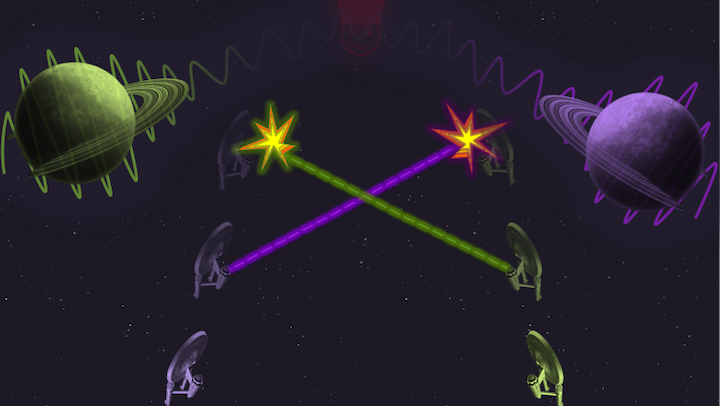23.08.2019

A starship exercise where two ships fire at each other. In a quantum future, an evil being can place a planet in superposition near one ship or the other, leading to both starships simultaneously destroying each other
Quantum mechanics boasts all sorts of strange features, one being quantum superposition – the peculiar circumstance in which particles seem to be in two or more places or states at once. Now, an international group of physicists led by Stevens Institute of Technology, University of Vienna and University of Queensland flip that description on its head, showing that particles are not the only objects that can exist in a state of superposition – so can time itself.
“The sequence of events can become quantum mechanical,” said co-author Igor Pikovski, a physicist at the Center for Quantum Science and Engineering at Stevens Institute of Technology. “ We looked at quantum temporal order where there is no distinction between one event causing the other or vice versa. So at the same time, A can cause B and B can cause A, in a quantum loop that blurs the lines of cause and effect.”
The work, reported in the August 22 issue of Nature Communications, is among the first to reveal the quantum properties of time, whereby the flow of time doesn’t observe a straight arrow forward, but one where cause and effect can co-exist both in the forward and backward direction. In the upcoming era of quantum computers, the work holds particular promise: quantum computers that exploit the quantum order of performing operations might beat devices that operate using only fixed sequences.
Pikovski and colleagues merged two seemingly conflicting theories – quantum mechanics and general relativity – to conduct a Gedanken experiment, a way of using the imagination to investigate the nature of things. The team, consisting of Pikovski, Magdalena Zych, Fabio Costa and Caslav Brukner, started by asking the question, “what would a clock measure if it was influenced by a massive object in a quantum superposition state, i.e. both near and far at the same time?”
According to general relativity, the presence of a massive object slows down the flow of time, such that a clock placed close to a massive object will run slower compared to an identical one that is farther away.
Based on that observation, the Gedanken experiment goes like this: imagine a pair of starships training for a mission. They are asked to fire at each other at a specified time and dodge the fire at another time, whereby each ship knows the exact time when to fire and when to dodge. If either ship fires too early, one will destroy the other, establishing an unmistakable time order between the firing events. That is, starship A fires before starship B, and starship A survives and starshp B is destroyed.
However, if a powerful agent could place a sufficiently massive object, say a planet, closer to one starship it would slow down its flow of time. As a result, the starship would be in line of fire of the attack and be destroyed.
Quantum mechanics complicates the matter. When placing the planet in a state of superposition near one starship or the other, both can be destroyed or survive at the same time. The sequence of events exists in a state of superposition, such that each starship simultaneously destroys the other as two separate events, llustrating for the first time how this quantum scenario can occur and how it can be verified.
“Moving planets around is hard,” said Pikovski. “But imagining it helped us examine a quantum aspect of time that was previously unknown.”
About Stevens Institute of Technology
Stevens Institute of Technology is a premier, private research university situated in Hoboken, New Jersey overlooking the Manhattan skyline. Since our founding in 1870, technological innovation has always been the hallmark and legacy of Stevens’ education and research. Within the university’s three schools and one college, 6,900 undergraduate and graduate students collaborate closely with faculty in an interdisciplinary, student-centric, entrepreneurial environment. Academic and research programs spanning business, computing, engineering, the arts and other fields actively advance the frontiers of science and leverage technology to confront our most pressing global challenges. The university is consistently ranked among the nation’s elite for return on tuition investment, career services and the mid-career salaries of alumni.
Quelle:Stevens Institute of Technology
